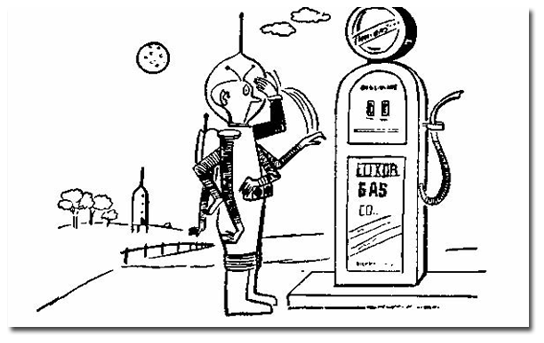
How To Develop A Super Power Memory > Contents > It Pays to Remember Speeches, Articles, Scripts and Anecdotes
I guess that one of the most embarrassing things that can happen to a person is to forget a speech while in front of his audience. Next to forgetting the speech, is the embarrassment of faltering along as if you're not sure of what you have to say. Actually, it seems to me that anyone who is asked to give a talk on any particular subject, must know that subject pretty well; otherwise why would he be asked to talk about it. No; speakers who falter or hesitate during their speeches, do so, I think, because they have forgotten the next word—or because they are fearful that they will forget the next word. There, in my opinion, lies the problem. If a speech is memorized word for word, and then a word, here and there, is forgotten; it surely will not be delivered as it should be. Why should you have to grope for one particular word? If you can't think of it; why, use any other word that serves the same purpose. Isn't that much better than hemming and hawing until you remember the exact phrasing just the way you memorized it? The people who realized this, felt that the next best thing would be to simply read the speech. This solves the problem of forgetting words, until you lose your place on the paper, and forget what you're talking about altogether. Besides, it seems to me that there is a subtle annoyance evident in an audience that is listening to someone reading a speech word for word. I know I feel that way: he might just as well have given me a printed copy of the speech to read at my own leisure. So, the next step seems to be not to prepare at all. Well, not quite. Even if you are well versed in your subject, you may forget some of the facts you want to speak about. As in the case of the itinerant preacher who always complained that he made his best speeches on the way home. All that he had forgotten to tell his listeners came to mind then, and his horse usually got the best part of the speech. I believe that the best way to prepare a speech is to lay it out thought for thought. Many of our better speakers do just that. They simply make a list of each idea or thought that they want to talk about, and use this list in lieu of notes. In this way, you can't forget words, since yon haven't memorized any. You can hardly lose your place; one glance at your list will show you the next thought to put into words. But, for those of you who would rather not rely on pieces of paper—the Link method can help you easily. If you wish to memorize your speech thought for thought, from the beginning to the end, you would be forming a sequence. That's why you would use the Link method of memory to memorize it. I would suggest that you go about it something like this:—First, write out or read the entire speech. When you're satisfied with it, read it over once or twice more to get the "gist" of it. Now, get yourself a piece of paper and start to list your KEY WORDS. Read the first thought of the speech. This might be contained in one, two or more sentences; it doesn't matter. Now select one word or phrase from these sentences which you think will bring the entire thought to mind! That is not at all difficult. In every sentence or paragraph there must be one word or phrase which will remind you of the entire thought. That one word or phrase is your Key Word. After you have found the Key Word for the first thought, find one for the next thought, and so on. When you're through with the whole speech, you'll have a list of Keys to remind you of each thing you want to say. Actually, if you were to keep this list in front of you as you made the speech, it would serve the purpose. But, if you've mastered the Link system, you know that it is just as easy to make a link of these Key Words, and then throw away the paper. You might, for example, be giving a talk on your local school problems at a Parent-Teacher Association meeting. Your list of Key Words might look something like this:— crowds, teachers, fire, furniture, subjects, playground, etc. In other words, you wish to start your speech with a reference to the crowded conditions in the class rooms. Then you want to talk about the teachers; perhaps about methods and salaries, etc. Now, you express your thoughts on fire drills and fire precautions, which leads you into your discussion on the state of the school's furniture; the desks, chairs, blackboards, equipment, and so on. Now, you would talk about your ideas on the subjects taught, and finally, the recreation (playground) facilities of the school. You can see that if you make a link: crowd associated to teacher; teacher to fire; fire to furniture, etc., each thought would lead you to the next one, right through to the end of your speech! At first, you may have to list, perhaps, two or three Key Words for some thoughts. List as many of them as you need, to remember the entire speech. As you use this idea, the amount of Keys necessary will be less and less. And, most important, the confidence you gain by knowing, that you remember your talk, will show when you deliver it. Just keep in mind that you must take care of the thoughts; the words will take care of themselves! If, for some reason or other, you wish to memorize a speech word for word, use the same method. You'll just have to go over it more often. Remember that all these systems are aids to your true memory. "If you remember the main, the incidentals will fall into place." You actually never forget anything you've remembered, you just have to be reminded of it; the system in this book will do that for you. So, if you remember the main thoughts of your speech, the incidentals, the ifs, ands and buts, will fall into place. The same ideas are used to memorize any article you read, if you desire. First read the article, of course, to get the "gist" of it. Then pick out the Key Words for each thought; then make a link to remember them, and you've got it. With a bit of practice, you'll actually be able to do this as you read. Many times while reading for enjoyment, I'll come across some piece of information that I'd like to remember. I simply make a conscious association of it, while I'm reading. This idea can, if used enough, speed up your reading considerably. I think that most people are slow readers because by the time they've reached the third paragraph, they've forgotten what was in the first; so they have to jump back. There is no need to associate everything; just the points that you feel are necessary to remember. Perhaps, if you use my systems, you will fall into the first class of readers in American educator, William Lyon Phelps' two classes. He once said, "I divide all readers into two classes; those who read to remember and those who read to forget." The same system of linking Key Words can be used for remembering lyrics and scripts. Of course, in this case it is usually necessary to memorize them word for word. You will have to go over them more often, but the Key Word idea will make the job that much easier for you. If you have trouble memorizing your cues in a play, why not associate the last word of the other actor's line to the first word of your line. Even if your cue tells you that you must perform an action, instead of speaking a line, you can still associate it. If the last word of the line prior to your action happens to be, say, "walk"; and the script calls for you to stoop down to pick up a cigarette butt—make a picture in your mind of yourself walking along and continually stooping to pick up cigarette butts. (In this way you will never walk on another actor's lines.) I'll mention one other use of the Key Word idea, before leaving it entirely. How many times have you wanted to tell your friends some jokes or anecdotes that you recently heard, only to find that you've forgotten them completely? You can hear a whole batch of really funny stories one day, and have them all, or most of them, slip your mind the next. Well, according to Irvin S. Cobb, "A good storyteller is a person who has a good memory and hopes other people haven't." Your memory for stories and anecdotes will improve immediately if you use the Key Word system. Just take one word from the story, a word from the punch line is usually best, that will bring the entire joke to mind. When you get your Key Words, you can either link them to each other to remember all the stories in sequence, or use the Peg system to remember them by number. Perhaps you've heard the gag that has been making the rounds recently about the Flying Saucer that landed in America. Out stepped a creature from outer space—brushed himself off with one of his six arms, looked around with the one large eye in the center of his forehead, and kept his antennae alert for any sounds. After exploring a bit, he finally approached a gas station, walked over to the gasoline pump, saluted, and demanded, "Take me to your President!"
Well, if you hadn't heard this before, and wanted to remember it with perhaps ten or twelve other stories—you could use either, flying saucer, creature from outer space or, gasoline pump as your Key Word for this story. Any one of these would surely bring the entire story to mind, if you liked it in the first place. Although I'm sure that many of you will find some practical use for it, one of the memory stunts I sometimes use in my shows is the "magazine test." This usually causes a bit of comment because it seems to be the most amazing of memory feats. Actually it is basic and simple. What happens is this:—The audience is given some copies of a current magazine. (I usually use Tempo Magazine, which is published by the Enterprise Magazine Management, Inc.) They are then asked to call any page number, and I immediately tell them the highlights of that particular page. This is merely another use of the Peg system of memory. In some instances the Link method is used in conjunction with the Peg, as will be explained directly. To memorize the pages of any picture magazine, all you have to do is to associate the peg word that represents the page number to the highlight of that page. For example:— If Page #1 has a picture of an airplane on it, you would make a ridiculous association between "tie" (1) and airplane. Page #2 might be an advertisement for shoe polish. Associate "Noah" to shoe polish. Page #3 has a picture of a horse on it. Associate "ma" to horse. Page #4 might have a picture of a circus scene; just associate "rye" to circus. Page #5 is an advertisement for a television set. Associate "law" to television set. Page #6 is a book review. Associate "shoe" to book. That's all there is to it. If you go over the magazine and your associations two or three times, you will know the highlights of every page. If a page has more than one picture on it, use the Link method to remember them. Assume that page #14 is a fashion page, and it has a picture of a hat, one of gloves and a third of a dress. First associate "tire" (14) to the first picture, which is of a hat. Now, link hat to gloves, and then gloves to dress. When Page #14 is called, the peg word will remind you of hat; hat will tell you that the next picture is of gloves, and gloves will remind you of dress. If you have seen my performance, you know that I also tell the audience on what part of the page the picture is located; whether it is on the lower or upper left part of the page, upper or lower right, or center, etc. Well, you can do this too, and without any extra effort. As I've already mentioned, your normal or true memory does most of the work for you; these systems are just aids that make it easier. As you use my systems you'll find your true memory getting stronger. The best example of this is in memorizing a magazine. In order to make the associations in the first place, you must really see and observe the picture on the page. Because of this, when any page number is called, the peg word for that number acts as an aid to enable you to almost reproduce the entire page in your mind's eye. You will know on what part of the page the picture is located. You can only prove this to yourself by trying it. The only thing you will not be able to do as yet, is to remember the names of any people pictured on the pages. This problem will be solved for you after you've read the chapters on remembering names and faces, and how to utilize substitute words or thoughts. Before reading any further, learn the last of the one hundred peg words.
For "cob," picture corn on the cob. For "fit," you can picture an epileptic fit, or a girdle (tight fit). For "file," you can use cither a filing cabinet or a nail file. "Fob" is a watch fob. For "bat," picture a baseball bat. For "puff," picture a ladies' powder puff, and for "pipe" see a man's smoking pipe. After learning these, you should be able to count from one to one hundred quickly, with your peg words only. The beauty of it is that you don't have to take time out to practice them. If you're traveling to work, or doing anything that doesn't require thought—you can go over all the pegs in your mind. If you go over them just every once in a while, they'll soon be as familiar to you as the numbers from one to one hundred. |
Last update:
Back to OwnWays.com
How to Develop a Super Power Memory
Copyright © 2007 OwnWays.com
Some Rights Reserved


